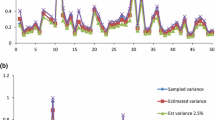Abstract
During past few years great attention has been devoted to the analysis of disease incidence and mortality rates, with an explicit focus on modelling geographical variation of rates observed in spatially adjacent regions. The general aim of these contributes has been both to highlight clusters of regions with homogeneous relative risk and to determine the effects of observed and unobserved risk factors related to the analyzed disease. Most of the proposed modelling approaches can be derived as alternative specifications of the components of a general convolution model (Molliè, 1996). In this paper, we consider the semiparametric approach discussed by Schlattmann and Böhning (1993); in particular, we focus on models with an explicit spatially structured component (see Biggeri et al., 2000), and propose alternative choices for the structure of the spatial component.
Similar content being viewed by others
References
Aitkin M A (1996) A general maximum likelihood analysis of overdispersion in generalized linear models. Statistics and computing6: 251–262
Aitkin M A (1999) A general maximum likelihood analysis of variance components in generalized linear models. Biometrics55: 117–128
Akaike H (1973) Information theory and an extension of the maximum likelihood principle. In: Petrov B N, Csaki F (eds.) Second international symposium on information theory. Akademiai Kiado, Budapest
Baddeley A, Turner R (2000) Maximum pseudolikelihood for spatial point patterns. Australian and New Zealand Journal of Statistics42: 283–322
Besag J, York J, Mollié A (1991) Bayesian image restoration, with two applications in spatial statistics (with discussion). Annals of the Institute of Statistical Mathematics43: 1–59
Biggeri A, Dreassi E, Lagazio C, Böhning D (2003) A transitional non-parametric maximum pseudolikelihood estimator for disease mapping. Computational Statistics and Data Analysis41: 617–629
Biggeri A, Marchi M, Lagazio C, Martuzzi M, Böhning D (2000) Non-parametric maximum likelihood estimators for disease mapping. Statistics in Medicine19: 2539–2554
Bindman A B, Grumbach K, Osmond D et al. (1995) Preventable hospitalizations and access to health care. Journal of the American Medical Association274: 305–311
Böhning D, Dietz E, Schlattmann P (1998) Recent developmentsin computer assisted analysis of mixtures. Biometrics54: 525–536
Böhning D, Schlattmann P, Lindsay B G (1992) Computer assisted analysis of mixtures (c.a.man): Statistical algorithms. Biometrics48: 283–303
Brannas K, Rosenqvist G (1994) Semiparametric estimation of heterogeneous count data models. European Journal of Operational Research76: 247–258
Breslow N E, Clayton D G (1993) Approximate inference in generalized linear models. Journal of the American Statistical Association88: 9–24
Brumback B A, Ryan L M, Schwartz J D, Neas L M, Stark P C, Burge H A (2000) Transitional regression models, with applications to environmental time series. Journal of the American Statistical Association95: 16–27
Clayton D G, Kaldor J (1987) Empirical bayes estimates of age-standardized relative risks for use in disease mapping. Biometrics43: 671–681
Cressie N, Stern H S, Reber Wright D (1999) Mapping rates associated with polygons. EPA Reprints, Ohio State University
Davies R B (1993) Nonparametric control for residual heterogeneity modelling recurrent behaviour. Computational Statistics and Data Analysis16: 143–160
Feng Z D, McCulloch C E (1996) Using bootstrap likelihood ratios in finite mixture models. Journal of Royal Statistical Society B58: 609–617
Fiscella K, Franks P, Gold M R et al. (2000) Inequality in quality: addressing socioeconomic, racial and ethnic disparities in health care. Journal of the American Medical Association283: 2579–2584
Giuffrida A, Gravelle H, Roland M (1999) Measuring quality of care with routine data: avoiding confusion betweenperformance indicators and health outcomes. British Medical Journal319: 94–98
Griffiths C, Sturdy P, Naish J et al. (1997) Hospital admissions for asthma in east london: with characteristics of local general practices, prescribing, and population. British Medical Journal314: 482–486
Heckman J J, Singer B (1984) A method for minimizing the impact of distributional assumptions in econometric models of duration. Econometrica52: 271–320
Kiefer J, Wolfovitz J (1956) Consistency of the maximum likelihood estimation of a mixing distribution. Journal of the American Statistical Association73: 805–811
Knorr-Held L, Besag J (1998) Modelling risk from a disease in time and space. Statistics in Medicine17: 2045–2060
Knorr-Held L, Raßer S (2000) Bayesian detection of clusters and discontinuities in disease maps. Biometrics56: 13–21
Laird N M (1978) Nonparametric maximum likelihood estimation of a mixing distribution. Journal of the American Statistical Association73: 805–811
Langford I H, Leyland A H, Rasbash J, Goldstein H (1999) Multilevel modelling of the geographical distribution of diseases. Journal of the Royal Statistical Society C48: 253–268
Lindsay B G (1983) The geometry of mixture likelihoods: a general theory. Annals of Statistics11: 86–94
Lindsay B G (1983) The geometry of mixture likelihoods, part ii: the exponential family. Annals of Statistics11: 783–792
Lindsay B G, Lesperance M L (1995) A review of semiparametric mixture models. Journal of statistical planning and inference47: 29–39
McLachlan G J (1987) On bootstrapping the likelihood ratio test statistic for the number of components in a normal mixture. Journal of the Royal Statistical Society C36: 318–324
McLachlan G J, Peel D (2000) Finite mixture models. Wiley, New York
Molliè A (1996) Bayesian mapping of disease. In: Gilks W R, Richardson S, Spiegelhalter D J (eds.) Markov chain Monte Carlo in practice. Chapman & Hall, London
Schlattmann P, Böhning D (1993) Mixture models and disease mapping. Statistics in Medicine12: 943–950
Schlattmann P, Böhning D (1996) Covariate adjusted mixture models with the program dismapwin. Statistics in Medicine15: 919–929
Zeger S L, Qaqish B (1988) Markov regression models for time series: A quasi-likelihood approach. Biometrics44: 1019–1031
Author information
Authors and Affiliations
Rights and permissions
About this article
Cite this article
Alfò, M., Vitiello, C. Finite mixtures approach to ecological regression. Statistical Methods & Applications 12, 93–108 (2003). https://doi.org/10.1007/BF02511586
Issue Date:
DOI: https://doi.org/10.1007/BF02511586




